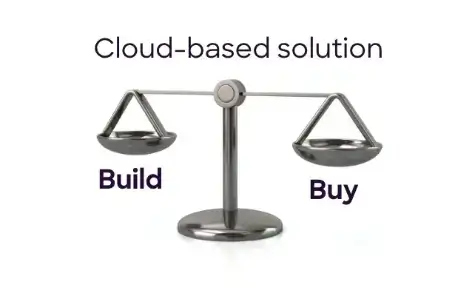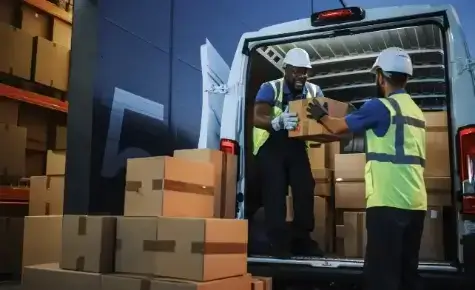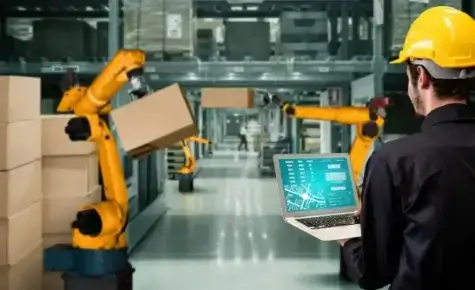Logistics Trends 2024:
AI to redefine technology landscape
In the wake of global disruptions and uncertainties, such as the COVID-19 pandemic, both businesses and human lives ground to a halt. It was the relentless efforts of logistics professionals and technological advancements that provided much-needed stability for consumers worldwide, ensuring timely supply of medicines and essentials.
Emerging from these unprecedented times, businesses have overhauled their supply chains to enhance their resilience and adaptability. This transformation has positioned them for the next phase of growth. However, to fully capitalize on these opportunities, they must remain attuned to the trends that will not only define their future success but also reshape the global logistics landscape.
As we approach the year 2024, it’s imperative to examine the trends that will serve as guiding lights, leading businesses toward a future marked by prosperity and innovation.
Generative AI: Shaping the future Of logistics for 2024 and beyond
Less than one-third of the business professionals mention that their organization adopted AI in only few multiple functions.
The logistics and supply chain landscape is currently undergoing a profound technological revolution. Amidst this wave of innovation, one advancement set to redefine the industry in 2024 is the incorporation of generative AI into logistics operations. Generative Artificial Intelligence encompasses algorithms and models capable of generating diverse data types, including video, images, text, 3D renderings, and code, based on trained input data.
Global research indicates a remarkable shift in the generative AI logistics market, poised to surge from its current valuation of $412 million to a staggering $13,948 million by 2032, demonstrating an astonishing CAGR of 43.5%. Notably, North America is anticipated to spearhead this transformation, experiencing substantial growth in the adoption of generative AI within logistics operations. The region currently commands the largest market share, standing at 43%.
CAGR in the generative AI logistics market

Generative AI is poised to revolutionize the logistics industry across multiple dimensions. Whether the aim is to minimize stockouts, optimize delivery routes, identify potential risks, suggest risk mitigation strategies, or enhance resource allocation, generative AI holds the promise of transformative impact. Its advanced capabilities will enable real-time communication enhancements among logistics teams, facilitated by generative AI-powered chatbots and virtual assistants. With the ability to tackle labor-intensive tasks like extensive report generation and forecasting, generative AI is primed to elevate productivity benchmarks for logistics professionals.
According to a recent report, the logistics and supply chain industries are expected to witness substantial growth in the adoption of AI in the years leading up to 2025. A McKinsey report revealed that 55% of business professionals confirmed that their organizations have already integrated AI technology into their operations. However, less than one-third of these professionals mentioned that their organizations had implemented AI across multiple business functions. This finding underscores the significant untapped potential for harnessing value from generative AI, particularly in light of the expanded integration opportunities with existing systems and various other business functions.
Unlock infinite possibilities in your supply chain with AI

One critical aspect that businesses are giving extra attention to in logistics is their ability to predict and respond to supply chain disruptions. A recent survey reported that 8,197 supply chain disruptions were recorded in the first half of 2023 alone, marking a 3% annual increase. Although the cost of disruptions has decreased, managing delivery delays remains one of the primary challenges for businesses.
The power of Generative AI can be used to forecast disruptions within supply chains. This involves analyzing the reasons behind unfulfilled planned deliveries and predicting the likelihood of delivery exceptions. Logistics experts and analysts concur that this technology holds the promise of introducing an entirely new realm of possibilities, one where human intervention in logistics management could potentially become obsolete.
For example, in cases of route deviations, unexpected weather anomalies, or potential breaches of Service Level Agreements (SLAs), technology like a control tower application, with its 360-degree visibility, can swiftly identify these issues. This enables operational managers and on-ground teams to efficiently address and manage them. In a recent survey, 69% of businesses reported that they lack necessary visibility over their supply chains. With generative AI applications like real-time fleet tracking and control towers, businesses can identify potential delays and take action before they significantly impact their business revenues.
Over the next few years, generative AI is expected to play a pivotal role in the logistics operations of enterprise businesses, reshaping industry practices and ushering in an era of unparalleled efficiency and innovation.
Addressing carbon emissions:
A global priority for businesses
Reducing carbon emissions is now a top priority for logistics businesses, and in 2024, it’s a subject that’s on everyone’s mind. Shippers and carriers are increasingly focusing on cost, capacity, service, and most importantly, carbon footprint. The numbers tell a compelling story.
Now, let’s delve into some crucial figures across four distinct geographical regions: the USA, Indonesia, the Middle East, and India. Each of these regions exhibits unique approaches to their business operations, consumer demands, and logistics strategies. By examining these diverse landscapes, we can gain valuable insights into the multifaceted nature of the logistics industry’s response to the pressing issue of carbon emissions.
In the global context, the United States remains the largest contributor to transportation emissions, accounting for nearly a quarter of the global total. In 2022, the U.S. transportation sector emitted a staggering 1.84 billion metric tons of carbon dioxide (GtCO2). There’s optimism that U.S. businesses will take stronger initiatives to reduce carbon emissions in 2024.
Indonesia, while not as swift as the U.S. in carbon reduction, is making progress. Recent surveys indicate that 74% of Indonesian consumers prefer sustainable brands, with 10% willing to pay more for sustainable products and services. This growing demand for sustainability is driving Indonesian businesses to cut carbon emissions in their logistics operations.

In the Middle East, a region central to global fuel production, there’s a shift toward technology investments aimed at reducing carbon emissions. In 2022, the Middle East’s carbon emissions were lower than North America and Asia Pacific (2200 million metric tonnes of carbon dioxide vs. 5851 and 17955 metric tonnes, respectively). However, these emissions have doubled since 2000. The GCC region is actively working on carbon reduction through green initiatives, such as investing in delivery management platforms, route optimization technologies, smart warehouses, and electric vehicles.
India, on the other hand, faces a significant sustainability challenge in its logistics operations. A recent report noted that India’s carbon emissions hit a record high at 1.91 metric tons in 2022, a 5.5% increase from 2021. With 86% of customers willing to buy sustainable products and 60% reducing purchases from non-sustainable organizations, logistics businesses in India are investing in transportation management systems, route planning software, and real-time fleet tracking solutions to address carbon emissions.
Why sustainability matters for the all-mile

Quick commerce revolution to make a comeback
Future prospects for quick commerce globally

Quick commerce, an e-commerce model focused on ultra-fast deliveries within an hour, is gaining momentum worldwide. In the USA, while seeing a slowdown in the past year, is expected to be on the rise again, given the level of convenience associated. Projections indicate quick commerce revenues will reach $30.8 billion in 2024, and key players like Gopuff, Instacart, and Getir are investing heavily in this quick commerce trend.
The Middle East is also embracing quick commerce, with companies like Talabat and RabbitMart offering deliveries within 20 minutes, and Deliveroo introducing rapid delivery in the UAE within 15 minutes. A report predicts that the rapid delivery e-commerce market will reach $20 billion in 2024 in the MENA region, with grocery delivery accounting for a significant share.
While quick commerce is still in its early stages in Indonesia, it is expected to grow substantially in the coming years, with a projected annual revenue of $3.6 billion by 2027. Changing consumer behavior in Indonesia and Southeast Asia is driving businesses to incorporate quick commerce into their operations.
India is experiencing rapid growth in quick commerce adoption, thanks to increased smartphone penetration and a tech-savvy population. Projections indicate a staggering annual growth rate of 49.5% for the quick commerce market, potentially reaching a market volume of $7.88 billion by 2027. With an expected 52.1 million users in India by 2027, investments in quick commerce are set to soar in 2024.
Locus' guide to quick commerce fulfillment

Embracing the future: The rise of asset-light logistics
In the fast-evolving landscape of logistics, a compelling trend set to gain prominence in 2024 is the growing preference among companies for an asset-light logistics model. This transformative approach empowers businesses to prioritize customer experiences while reducing their reliance on physical assets for operations, ultimately resulting in lower operational costs compared to asset ownership. The upsurge in warehouse expenses, escalating fleet management costs, and the complexities of the labor market are driving the surge in adoption of this asset-light logistics paradigm.
Statistics reveal that a significant 67.5% of companies worldwide now entrust their transportation operations to third-party logistics (3PL) providers, while 63.5% outsource their warehousing operations to similar entities. A recent survey underscores the financial impact of transportation costs, which contribute to over two-thirds of total business logistics expenses, particularly in the United States.

Consider the challenges faced by businesses that own their fleets – substantial expenditures on labor, fuel, vehicle maintenance, scaling, and replacement costs. Adapting to fluctuating market conditions, especially during slower seasons, becomes a daunting task, often resulting in excess capacity. Asset-light logistics models offer a nimble alternative, allowing businesses to efficiently navigate peak shipping periods in various geographical regions, including Diwali, Ramadan Raya, and holiday seasons. Traditional logistics models, marked by capital-intensive and high-fixed costs, are proving to be increasingly burdensome for today’s growing enterprises.
The key to meeting the escalating demands and heightened expectations of modern consumers lies in embracing Multi-Carrier Parcel Management Solutions. However, not just any platform will suffice – it must enable businesses to maintain branded tracking visibility akin to owning a fleet, even if they choose to outsource their fleet operations. Tech platforms like Locus empower businesses to seamlessly transition to an asset-light model. Locus’ Multi-Carrier Parcel Management Solutions helps them identify the right carrier partners aligned with their efficiency standards, cost requirements, and overall business objectives.
As we move into 2024, the asset-light logistics model is poised to disrupt the industry, offering businesses a dynamic, cost-effective, and agile approach to meet the ever-changing demands of the modern marketplace.
Cloud-based revolution set to transform logistics
In today’s dynamic business landscape, logistics professionals face unprecedented pressure to enhance profitability, trim costs, and streamline logistics operations for greater efficiency. The escalating complexities across the first, mid, and last mile segments pose significant challenges to decision-making in the logistics arena.
Amidst these challenges, cloud-based solutions emerge as a pivotal force, driving the digital transformation of logistics operations. Beyond addressing inefficiencies and mitigating risks, these solutions offer businesses a host of advantages including speed, cost-effectiveness, control, scalability, and security.
One of the standout trends expected to reach its zenith in 2024 is the widespread adoption of cloud-based solutions by enterprises to manage their logistics operations. The numbers paint a compelling picture of this impending shift.

A report projects that within the next five years, a staggering 86% of supply chain-based companies will incorporate cloud computing into their operations. This is a substantial leap from the current 40% adoption rate, highlighting the growing recognition of cloud-based solutions’ value. Another research study predicts that the global cloud supply chain management market is set to skyrocket from USD 21.79 billion in 2022 to an estimated USD 71.93 billion by 2030, driven by a robust CAGR of 16.10%.
CAGR in the global cloud supply chain management market

As the adoption of cloud-based solutions in logistics skyrockets in 2024, a crucial question looms for businesses: whether to build an on-premise solution or opt for a ready-made cloud-based solution.
Building an in-house solution offers the advantage of customization and complete control over data handling and storage costs. However, it comes with significant downsides, including maintenance expenses during scaling, integration costs, time-to-value challenges, expertise requirements, and substantial research and development expenditures.
Enter the alternative choice - investing in a cloud-based logistics solution. Purchasing such a solution offers scalability in infrastructure to meet increasing demand, all while remaining cost-effective by eliminating the need for hardware infrastructure. Importantly, businesses can seamlessly integrate these cloud-based solutions into their existing applications, avoiding the need for complete replacement.
In 2024, we are poised to witness enterprises significantly augment their investments in cloud-based logistics solutions. As businesses seek to navigate the evolving logistics landscape with greater agility, efficiency, and cost-effectiveness, the cloud-based revolution will play a pivotal role in reshaping the industry.
Buying vs. Building logistics software: How to choose?

2024 - Delightful customer
experience + maximum profitability + sustainability
2024 is all about the perfect blend of customer delight, improving profitability through optimization, and an unwavering commitment to sustainability. These three pillars are poised to be the cornerstones of success for businesses venturing into the global logistics arena. How well they perform in these domains will essentially define their standing in the market.
But here’s the intriguing twist – there’s a fourth, often overlooked, element that’s set to play a pivotal role in shaping the triumvirate of customer satisfaction, profitability, and sustainability. The burning question on every forward-thinking business’s mind as they peer into the future of logistics is: Which tech platform can truly elevate their logistics game? Enter Locus’ transportation management platform.
Locus’ transportation management system isn’t just another tech tool; it’s a game-changer. Packed with an array of customer-friendly features such as route optimization, a driver companion app, control towers, delivery-linked checkout, third-party delivery orchestration solutions, and geocoding, it’s the secret sauce that can supercharge your logistics operations.
And the best part? You don’t need to overhaul your existing systems and break the bank to implement it. Locus’ platform seamlessly integrates with your current tech infrastructure, adding a layer of advanced machine learning algorithms that enhance scalability, flexibility, and minimize the need for human intervention. The result? Logistics that are not just cost-effective but customer-friendly, efficient, and remarkably profitable.
So, if you are on the hunt for the ultimate tool to keep your business ahead of the logistics curve in 2024, look no further.





